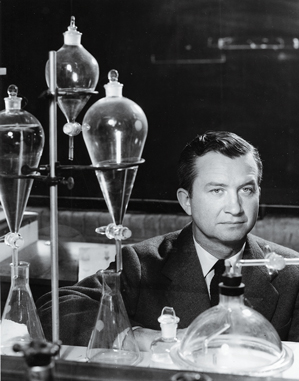Solving the “Impossible Problem”
One afternoon in 1942, Randolph Major, the director of research at Merck Pharmaceuticals, called an employee into his office to offer him a choice of projects. John Clark Sheehan, just 27 at the time, had his pick between research on two interesting compounds: the steroid cortisone and the antibiotic penicillin. But when Sheehan said he’d be most comfortable with steroid research, Major interrupted him: Lewis Sarett, a recent hire, was also qualified in this area.

Sheehan had already heard that penicillin was “a remarkable drug but very difficult to work with chemically,” he would later recall in his autobiography, The Enchanted Ring. But he took the hint. “If it is all right with you, Dr. Major, I’ll take the penicillin,” he said. Sheehan was about to begin the scientific mission that would define his career.
Penicillin research was just taking off. Alexander Fleming, a British bacteriologist, had discovered the compound by accident in 1928, when he noticed a contaminant that turned out to be Penicillium mold inhibiting growth on his plate of Staphylococcus bacteria. It would take another decade to isolate the specific antibiotic compound within the mold, but by the end of World War II, factories were pumping out penicillin for civilians and soldiers by extracting the active ingredient from Penicillium.
Since the mold was slow-growing, however, scientists were eager to make the drug synthetically. Many believed it would be easy to reproduce in the lab.
They soon learned otherwise. Penicillin synthesis became known as “the impossible problem.” Sheehan suggested that “the penicillin molecule was designed by nature to teach organic chemists a little humility.”
Sheehan left Merck in 1946 to join the faculty at MIT, but he brought the “impossible problem” with him. Though his friends pressured him to give up penicillin research in favor of more impressive academic projects, he persisted for personal reasons: as a college student, he’d lost a year, and nearly his life, to pneumonia and the skull infection mastoiditis. “If my doctors had had a course of treatment as effective as that made possible by penicillin, I would probably not have lost that year,” he later wrote. He also felt that someone was sure to solve the puzzle of penicillin. “I wanted to be that person,” he said.
Attempting to synthesize the “fragile and reactive” penicillin molecule with available methods was “like attempting to repair a fine Swiss watch with a blacksmith’s anvil, hammer, and tongs,” Sheehan once said. His laboratory progressed slowly, developing several compounds he described as “foothills on the way to the peak.”
The search was not only arduous but lonely. At the height of the war effort, nearly 40 laboratories had attempted to make penicillin from scratch. From 1948 onward, Sheehan was the only one still at work on the problem. Explaining why everyone else gave up, he said: “Chronic frustration does odd things to people.”
In October 1952, Sheehan wrote a letter congratulating Lewis Sarett, his former coworker at Merck, for synthesizing cortisone, completing the project that he himself had forgone a decade before. Today, the steroid is used to treat inflammation, arthritis, and more. “Thanks for your good wishes,” Sarett replied. “We are banking on you to put the final nail in the coffin of the superbugs!”
Three years later, in 1955, Sheehan’s group had a breakthrough at last when it found a new way to form a chemical bond necessary in the construction of penicillin. By the next year, his laboratory had also successfully synthesized the chemical center of penicillin—two rings of sulfur, carbon, and other atoms known as 6-aminopenicillanic acid.
In March 1957, Sheehan sent a vial to Bristol Laboratories in New York containing a chain of carbon, hydrogen, and oxygen atoms called an acyl group, fused to 6-aminopenicillanic acid. This matched the structure of penicillin V, a form of penicillin previously found only in nature. The analysis came back quickly: his sample showed antibiotic activity. After 15 years of work, Sheehan had synthesized penicillin.
Sheehan, who died in 1992, would often think back on that day at Merck, and of Sarett, who took the path he opted against and later became president of Merck Sharp & Dohme Research Laboratories. “I have sometimes joked with [Sarett] about what would have happened if we had reversed roles,” Sheehan said. “My own guess is that we both would have failed.”
Keep Reading
Most Popular
Large language models can do jaw-dropping things. But nobody knows exactly why.
And that's a problem. Figuring it out is one of the biggest scientific puzzles of our time and a crucial step towards controlling more powerful future models.
The problem with plug-in hybrids? Their drivers.
Plug-in hybrids are often sold as a transition to EVs, but new data from Europe shows we’re still underestimating the emissions they produce.
Google DeepMind’s new generative model makes Super Mario–like games from scratch
Genie learns how to control games by watching hours and hours of video. It could help train next-gen robots too.
How scientists traced a mysterious covid case back to six toilets
When wastewater surveillance turns into a hunt for a single infected individual, the ethics get tricky.
Stay connected
Get the latest updates from
MIT Technology Review
Discover special offers, top stories, upcoming events, and more.